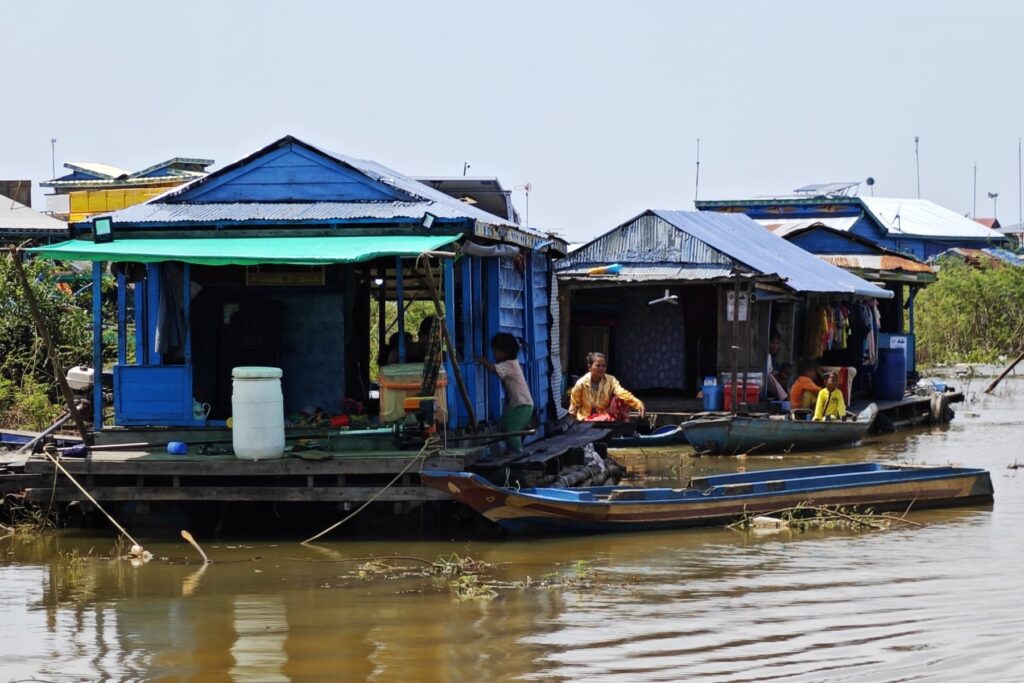Livelihoods Have Dried Up Due To Pollution In This Lake
Feb 6, 2024 | Pratirodh Bureau
Residents of floating villages near the banks of Tonle Sap Lake rest on wooden decks. They say they have seen fish stocks decline as a result of poor water quality and overfishing in the lake (Image: Sokom Kong)
Southeast Asia’s largest freshwater lake, the Tonle Sap in northwestern Cambodia, is facing a water quality crisis, forcing villagers who have lived in traditional floating houses to consider making new lives on the land. But their resettlement can come with costs and livelihood changes.
Despite generations of his family living in a floating village on the lake, Chhun Channy now yearns for a new life on dry land.
“The water is not as good as it used to be,” says the fisherman from Number 2 Village in Kompong Luong Commune, Pursat province. “About eight years ago, when it rained, you would see fish everywhere. It’s nothing like that now.”
Channy is one of 80,000 residents who live in the floating villages. Their lives depend on the ebb and flow of Tonle Sap Lake – a part of the Mekong River’s flood pulse system that sustains the fishing industry and provides incomes for millions of people. Many in his village are considering leaving, as dwindling fish stocks mean they are no longer able to sustain themselves.
Cambodia is heavily dependent on its inland fisheries and ranks as one of the world’s top inland fish producers, with approximately 400,000 tonnes annually – placing it fourth behind China, India, and Bangladesh, despite their significantly larger populations. In terms of consumption, it ranks first on a per capita basis. Fish is a major part of the Cambodian diet, accounting for 61% of households’ animal protein intake, and is the second most consumed food after rice.
However, the deteriorating water quality of Tonle Sap, coupled with overfishing, are among key factors contributing to declining fish stocks and prompting migration to dry land.
One study highlighted the growing impact of unsustainable human activities on the Tonle Sap floodplain, leading to health issues, ecosystem degradation and biodiversity loss. Monitoring by Cambodia’s Ministry of Environment reveals elevated nitrogen and phosphate levels in certain lake areas, exceeding water quality standards. These contaminants can adversely affect fish health and reproduction, causing gill damage, neurotoxic effects, and other severe health complications.
Lower fish catches have compelled Channy to shift from fishing to aquaculture and poultry farming. He has observed changes in the water’s appearance, noting occasional blackish hues resembling oil-water mixtures, particularly during temperature spikes. Meanwhile, his wife sustains the family by selling fruit; yet their incomes fall short, especially for their children’s education, prompting consideration of relocation to dry land.
Sources Of Wastewater
Tonle Sap Lake, designated a Unesco Biosphere Reserve since 1997, faces mounting pressures from a growing population and human activity, including infrastructure development and deforestation, as well as climate change.
Over the past decade, declining water quality has adversely affected villagers in various ways, including causing reduced incomes from fishing and deteriorating health due to poor sanitation.
The government attributes water pollution in the lake to ineffective waste management in surrounding cities and floating villages. Collaborative research by the Institute of Technology of Cambodia revealed alarming figures, with over 234 tonnes of faeces discharged into water sources daily, 77 tonnes of which end up in the lake.
In Kompong Luong floating village, Channy observed residents directly disposing of waste into the water. Many households, facing poverty, commonly use open toilet systems that contaminate the lake water they rely on for daily use. This pollution has impacted fishermen like Suy Seth, who spends 10-hour days in contact with the contaminated water. Prolonged exposure to polluted water has resulted in Seth and his family contracting skin diseases, along with stomach problems and diarrhoea, which particularly affects his children.
A 2019 study found that residents of Tonle Sap Lake are at significant risk of waterborne illnesses, especially during the dry season. Despite this, Seth and his family persist in using water collected from beneath their home. They filter it in plastic tanks to remove debris, using it for bathing and occasionally cooking. However, they must purchase drinking water, a costly essential due to water quality concerns.
